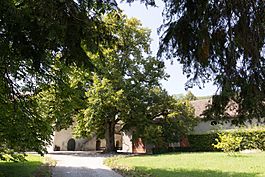Luins facts for kids
Quick facts for kids
Luins
|
||
|---|---|---|
 |
||
|
||
| Country | Switzerland | |
| Canton | Vaud | |
| District | Nyon | |
| Area | ||
| • Total | 2.67 km2 (1.03 sq mi) | |
| Elevation | 457 m (1,499 ft) | |
| Population
(Dec 2020 )
|
||
| • Total | 619 | |
| • Density | 231.8/km2 (600.5/sq mi) | |
| Demonym(s) | Les Luinois Lè Pllianta-saudzon |
|
| Postal code |
1184
|
|
| Localities | Le Vernay | |
| Surrounded by | Burtigny, Vinzel, Bursins, Dully, Gland, Begnins | |
Luins is a small town, also called a municipality, located in the Nyon area of the Vaud region in Switzerland. It is known for its beautiful scenery and being part of a wine-growing area.
Contents
History of Luins
Luins was first mentioned in official records way back in 1115. This means it has been a recognized place for over 900 years!
Geography of Luins
Luins covers an area of about 2.7 square kilometers (about 1 square mile). A large part of this land, almost 75%, is used for farming. About 11% of the area is covered by forests. The rest of the land, around 13.5%, has buildings and roads. A very small part, less than 1%, is made up of rivers.
Most of the built-up areas are homes and other buildings. The forested land is mostly dense forests. On the farms, a lot of the land is used for growing crops, especially vineyards, as Luins is in a famous wine region.
Luins used to be part of the Rolle District. But in 2006, it became part of the new Nyon area. The town itself is a linear village, meaning it stretches out along a road. It also includes a small group of houses called Combes and parts of a former village called Le Vernay.
Luins' Coat of Arms
A coat of arms is like a special symbol or logo for a town or family. Luins' coat of arms is split into two halves: one silver and one red. On this shield, you can see three wings. Two wings are at the top, and one is at the bottom. They are colored opposite to the background they are on.
Population and People of Luins
Luins has a population of about 580 people. In recent years, the number of people living in Luins has grown quite a lot. Many new residents have moved here.
Most people in Luins speak French, which is the main language. Some people also speak Portuguese or English.
The population of Luins includes people of all ages. Many children and teenagers live here, making up a good part of the community. There are also many adults and older people.
Most homes in Luins are private households, with an average of about two people living in each. There are also some single-person households and a few larger families. Many of the buildings in Luins are single-family homes.
Important Heritage Sites
Luins Castle is a very important historical site in Switzerland. It is recognized as a national heritage site. This means it's a special place that helps tell the story of the country. The entire small village of Luins is also part of the Inventory of Swiss Heritage Sites, which means it has a special historical value.
Economy and Jobs in Luins
In Luins, people work in different types of jobs. Many people work in the primary sector, which means they work in agriculture, like farming or growing grapes for wine. There are also jobs in the secondary sector, which includes manufacturing and construction. The tertiary sector includes jobs in sales, hotels, restaurants, and education.
Many people who live in Luins travel to other towns for work. However, some people also come into Luins from other places to work. Most people use a private car to get to their jobs, but some also use public transportation.
Religion in Luins
In Luins, many people belong to the Swiss Reformed Church, which is a Protestant church. A good number of people are also Roman Catholic. There are also some people who belong to other Christian churches or do not follow any religion.
Education in Luins
Education is important in Luins. Many adults have finished high school, and a good number have gone on to higher education, like university.
The local school system provides education for children. There are primary schools for younger students. After primary school, students go to lower secondary school. Some students are also homeschooled or attend other types of schools.
Some students who live in Luins go to schools in other towns, and some students from other towns come to school in Luins.
Images for kids
See also
 In Spanish: Luins para niños
In Spanish: Luins para niños






